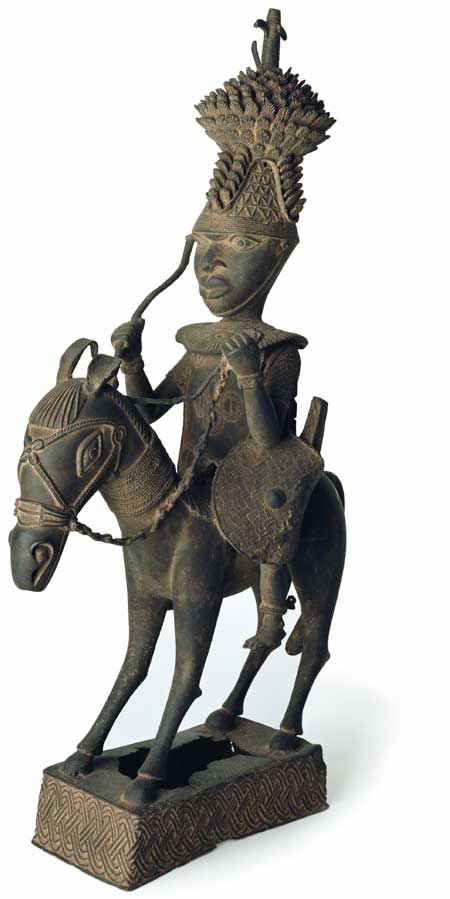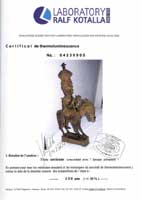Galerie Peter Herrmann |
- | Ancient Art from Africa |
||
 |
| Horseman | Thermoluminescence - Expertise |
| Benin, Nigeria 16th century Bronze 67 cm |
 |
| Horseman |
This object is the oldest of the three horsemen and the most graceful. The head covering is decorated with large quantities of parrot feathers, rendered with remarkable accuracy and painstaking care. The horseman sits loftily upon his steed, which, like its rider, exudes vibrancy and elegance. The overall result is a dynamic rendering of figures apparently captured in motion. The identity of this and similar equestrian figures from Benin has been widely interpreted. In 1919, Luschan offered the first hypothesis: that the uncommon headdress and clothing indicated that the person depicted was a foreigner. Dark classified the figure more specifically, interpreting him as a Yoruba warrior, in large part because of the size of his horse. Fagg, on the other hand, argues that he is an emissary from an Emirate in northern Yoruba, basing his judgement on the figure's headdress. According to other researchers (Tunis, Karpinski), though, the bronze depicts a king of Benin. This argument is substantiated by the well-known American Benin researcher Paula Ben-Amos, who connects the horseman to Oranmiyan, the founder of the current dynasty (ca. 1200) who is said to have come from the Ife kingdom and introduced horses to Benin. Meanwhile, Nevadomsky advanced two other theories regarding a similar horseman: in the first, he argued that the figure represents the ruler of the Igala, Attah von Idah; in the second, that it represents Oba Esigie (ca. 1504-1550). (Dorina Hecht, 2008) Meanwhile I was reading such a lot of nonsens from the above mentioned scientists, that it might be the best to say: we do not know anything about that rider. (Peter Herrmann, 2016) Cp.: |
| Similar objects : | Illustration: |
| Staatliche Museen zu Berlin, Ethnologisches Museum | Felix von LUSCHAN: Die Altertümer von Benin, Band 1-3, Berlin 1919, Tafel 73. |
Hans-Joachim Koloss (Hg.): Afrika, Kunst und Kultur. Meisterwerke afrikanischer Kunst. Museum für Völkerkunde Berlin, München 1999, S. 65. |
Kopf - British Museum in London, Rumpf - Slg. für Völkerkunde Zürich |
Die Kunst von Schwarz-Afrika, Recklinghausen, 1972, S. 168. |
| General Pitt Rivers's Museum at Farnham, Dorset (Objekt bei der Militärintervention 1897 erbeutet) | Augustus Henry PITT-RIVERS: Antique Works of Art from Benin, London 1900 (Reprint 1971), S. 27. |
| British Museum, London | Paula Girshick BEN-AMOS: The art of Benin, London 1995. |
Barbara PLANKENSTEINER (Hg.): Benin. Könige und Rituale. Höfische Kunst aus Nigeria, Wien 2007, S. 448. |